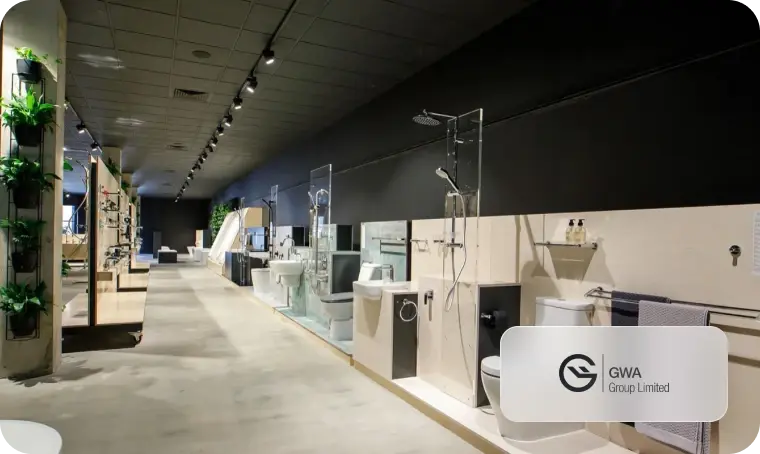With the adoption of online shopping and retail, customers got used to convenience and round the clock customer support that often felt missing in the pre-digital shopping era. While a great deal of retail segments enjoyed success with digital channels, high end retail segments, such as jewelry could not mount the same scale of adoption. Advancement of Augmented Reality(AR) holds the potential to offer a similar “try-and-buy” experience as that of a brick-and-mortar store, thus delivering an immersive cross-channel experience.
In 2020, 83.1 million people used AR at least once per month in the United States and the corresponding figure is expected to reach over 95 million users by 2022.
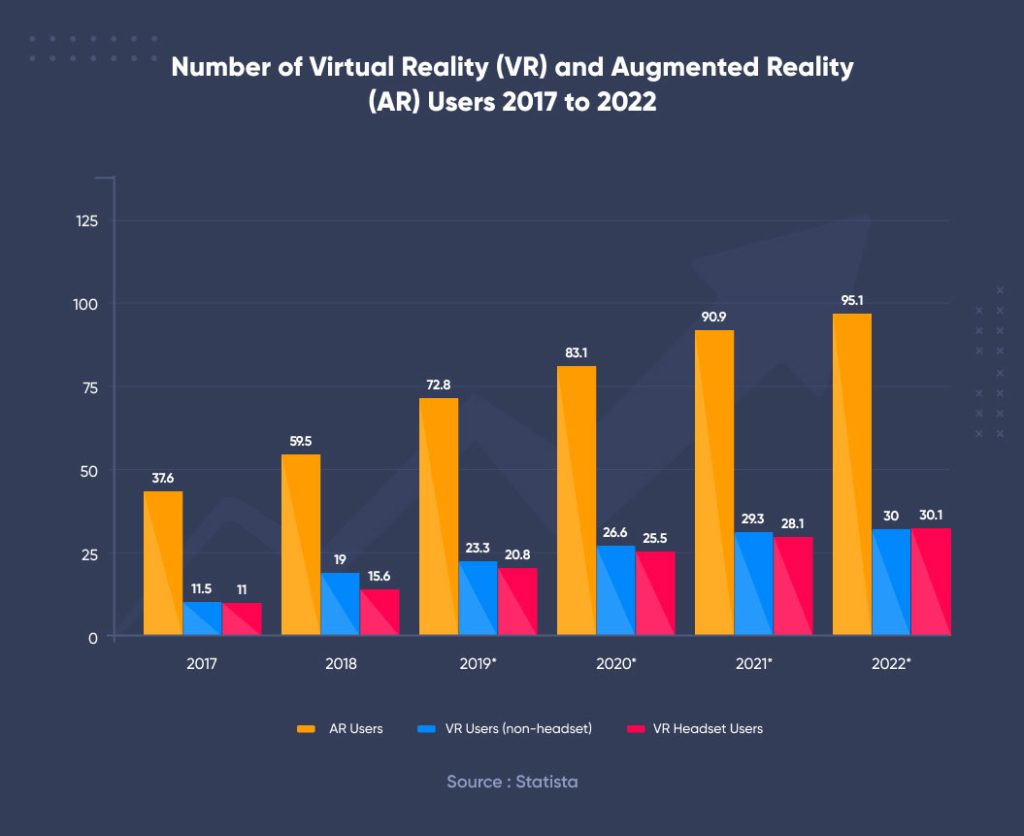
The integration of technology into everyday life has been further accelerated due to social distancing. As individuals seek to stay connected, tools like virtual reality(VR) and augmented reality(AR) help bridge the gap between reality and digital experiences.
AR-powered wearable devices and other digital assets have resulted in smart and immersive lifestyles while taking user experience to the next level. When it comes to the jewelry industry, AR has proved its potential while taking the shopper’s experience to the whole new level.
A noteworthy feature in the jewelry augmented reality sector that changed the perceptions of many is virtual try-on jewelry application. Jewelry is a bespoke of a person’s personality and emotions. Such an integral part of accessorizing and dressing up requires a great deal of trust in the product and the experience as well. Digital transformations so far have been handicapped in delivering the brick-and-mortar experience to jewelry shoppers but the introduction of AR has set jewelry brands looking to leverage digital platforms up for success.
61% of shoppers prefer retailers with AR over those that don’t.
Being primed up for success with the help of AR is not enough. Once you know that you will be investing in AR technology to boost your jewelry business, you have to understand what it takes to successfully pull off utilising AR and the challenges that stand in your way.
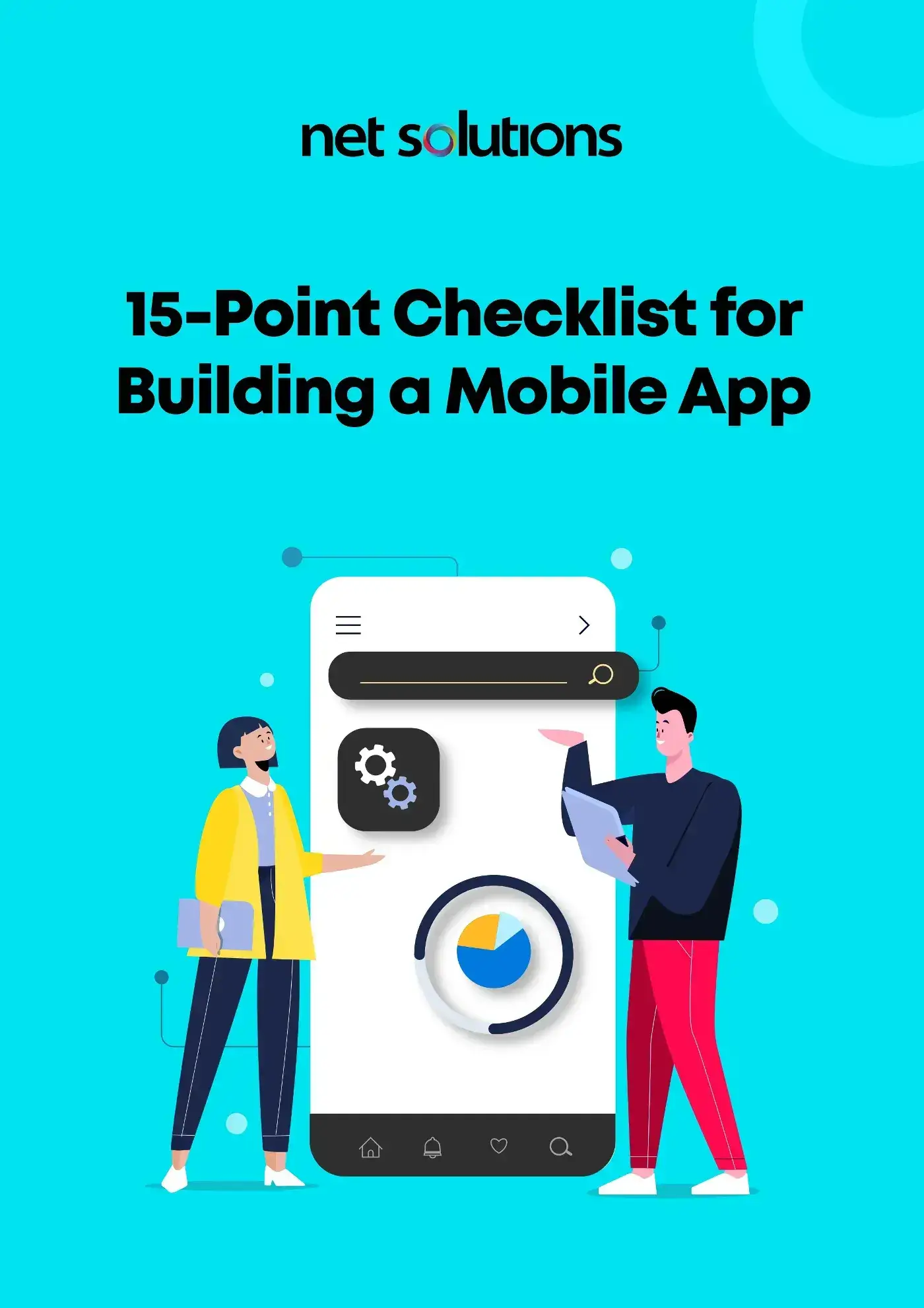
We respect your privacy. Your information is safe.
Challenges Jewelry Businesses Face
Challenges for jewelry businesses can stem from technological hiccups, IT and infrastructures, hiring the right mobile app development team, and limitations of available technology.
Presenting new jewelry designs in real-time, grabbing the attention of the customers, and convincing them to buy- there are a lot of issues jewelry business owners encounter. When it comes to the jewelry business, virtual reality (VR) and augmented reality (AR) are standing tall on their promises and assisting the entire industry in the form of AR jewelry try-on apps.
By merging the gap between the real and virtual world, AR is empowering customers to feel more confident which helps businesses to attract their target audience backed by smart yet hassle-free AR experiences. Augmented reality in the form of virtual jewelry try-on solutions helps in saving the time and efforts of the customers which they otherwise have to spend at a brick-and-mortar store.
Customers get to live the store going experience and the chance to create a mental imagery of owning and wearing their favorite jewelry.
Why Use Augmented Reality for Virtual Jewelry Try-On App?

Augmented reality for jewelry is the disruptive technology that has managed to attract user attention in recent years. It is a golden opportunity for jewelry retailers to get ahead of their competitors in the digital world.
Virtual try-on jewelry software has turned out to be a success for modern jewelry businesses in terms of offering an excellent user experience with a rapid elevation in business sales.
Statista predicts that by the year 2022, the retail industry will be representing 5% of the augmented and mixed reality software market, and it’s forecasted AR in retail will reach $80 billion in 2022.
As per a report by Business Wire, 40 percent of respondents said they would be willing to pay more for a product if they could experience it through AR and 72 percent said they had purchased items they had not planned on because of augmented reality.
Here are some benefits of AR for your business.
1. Offer a Cross-Channel Customer Experience
As the old saying goes- hedging your bets is the way to go. The COVID-19 outbreak brings that lesson into limelight — always have a business continuity plan in hand.
There is a need to consider digital transformation seriously. By offering an AR-powered virtual jewelry try-on app, you will ensure all-time availability through different channels.
It is about extending your services beyond the brick and mortar setups so that you can meet your customers where they are.
2. Avoid the Hassle of Returns
The biggest concern for online jewelry sellers — the vicious cycle of returns because the buyer does not feel satisfied.
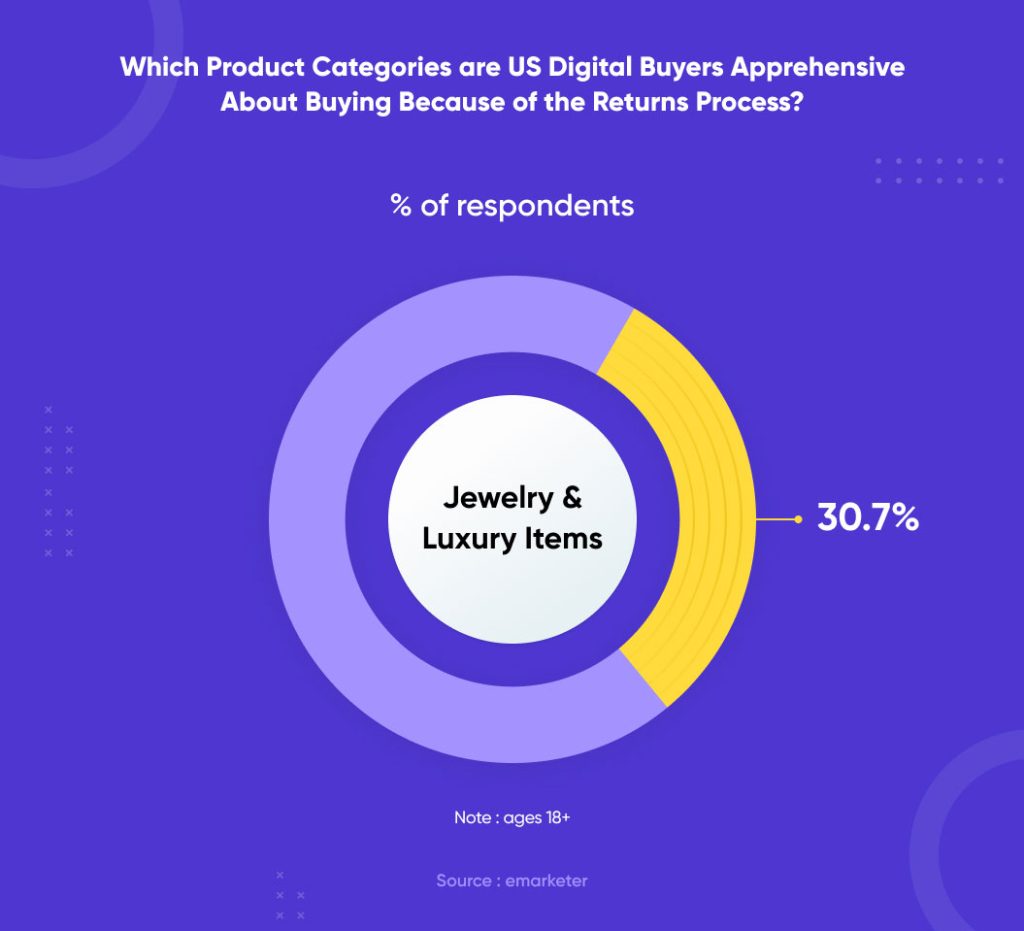
Virtual jewelry try-on applications let the end-user try and buy virtually, which enables them to visualize the look and the feel of the ornament, which, in turn, drives their purchasing decisions. This provides an unparalleled opportunity for reducing return rates and improving customer satisfaction. and exchanges.
3. Gaining a Competitive Edge
Businesses who fail to incorporate digital transformation at the heart of their strategy will struggle to stay relevant in this era. The reasons why jewelry businesses are struggling are hesitation around the sizing, the look and feel, and the high costs involved.
Augmented reality jewelry app is the breakthrough technology that offers jewelry retailers an opportunity to offer a store-like experience online. The investment is low in comparison to the value the technology will provide in the long run.
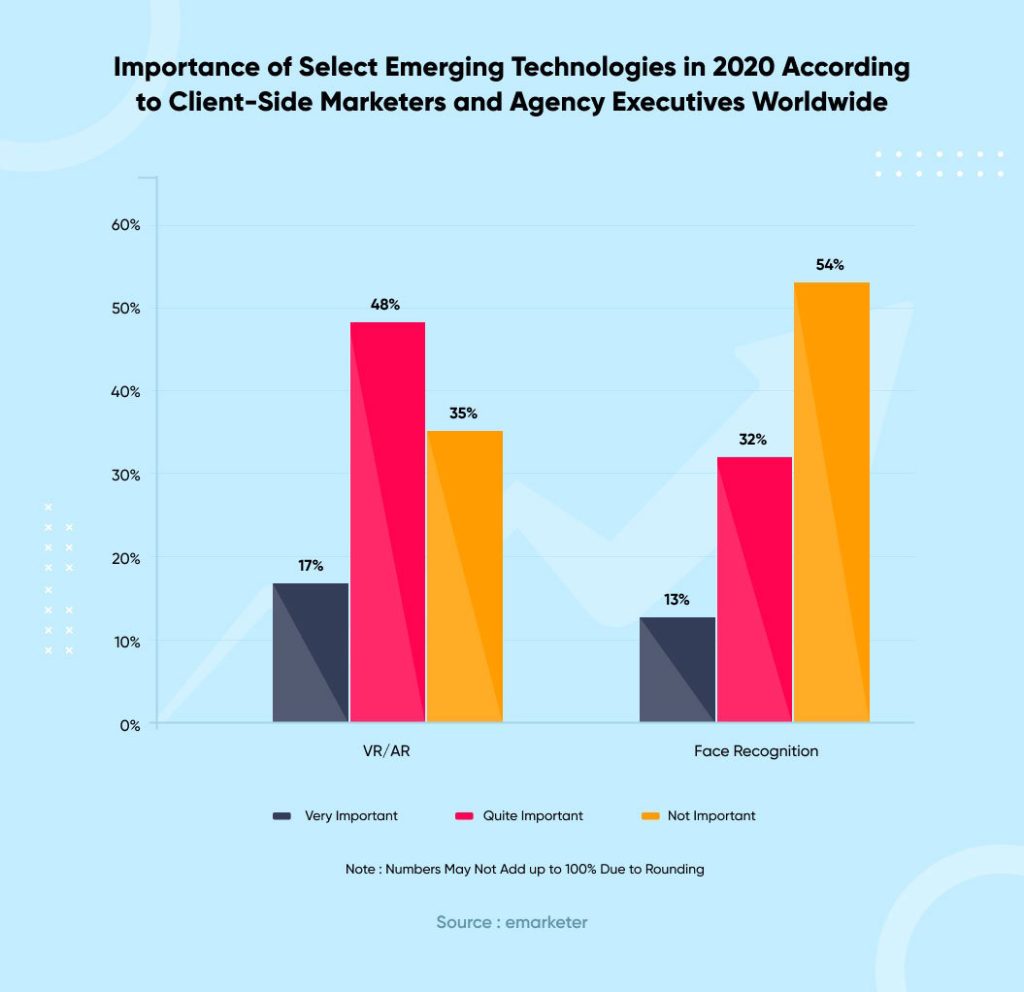
It is about staying ahead of the pack by accelerating the digital transformation efforts and adhering to the industry’s demands.
| Customer Benefits | Business Benefits |
|---|---|
| Try the look and feel anytime, anywhere | Digital platform with maximized customer engagement |
| Hassle-free try-it-on functionality | Minimize frictions, maximize conversions |
| Personalized recommendations | In-depth reporting & analysis |
| Save time, costs, and efforts related to visiting brick-and-mortar stores | Customer retention |
| Customized 3D experiences | Strengthen brand recognition |
How Net Solutions Helped Deliver a Virtual Jewelry Try-On App?
Net Solutions helped a client build an augmented reality app for jewelry for iOS. The innovative AR application for retail was built using augmented reality mixed with face recognition.
Apple’s Vision, SceneKit, and AVFoundation frameworks majorly contributed towards turning the idea into reality. Here’s a brief into each of these frameworks.
1. What is the Vision Framework?
Apple’s Vision Framework is an easy-to-use framework that experiments with computer vision and machine learning. Vision helps perform multiple tasks on input images and video clips.
The Vision framework performs face and face landmark detection, text detection, barcode recognition, image registration, and general feature tracking. Vision also allows the use of custom Core ML models for tasks like classification or object detection. — Apple
Apple introduces year-on-year iterations to the framework to add exciting updates.
At WWDC 2019, Vision Framework was iterated to use machine learning to detect cats and dogs in the images. At WWDC 2020, Apple introduced hand, body pose detection to the Vision Framework for developers.
Vision Framework is empowering several innovative mobile application development efforts.
2. What is the AVFoundation Framework?
AVFoundation helps development teams add powerful media features to the applications.
AVFoundation is the full-featured framework for working with time-based audiovisual media on iOS, macOS, watchOS, and tvOS. — Apple
3. What is SceneKit Framework?
SceneKit enables developers to add 3D content to the applications with the aid of high-level scene descriptions.
SceneKit combines a high-performance rendering engine with a descriptive API for import, manipulation, and rendering of 3D assets. — Apple
How to Build a Virtual Jewelry Try-On Application?
Our Agile development team shares a common objective — to ensure a faster time to market and deliver a high-quality end product.
This objective and our agile scrum practices helped us deliver the AR jewelry app. Here’s the development story that might interest you.
1. Set up a Live-Streaming Session with AVFoundation
Apple enables you to set up an HTTP live streaming session with the help of AVFoundation. Here’s a piece of code that will help.

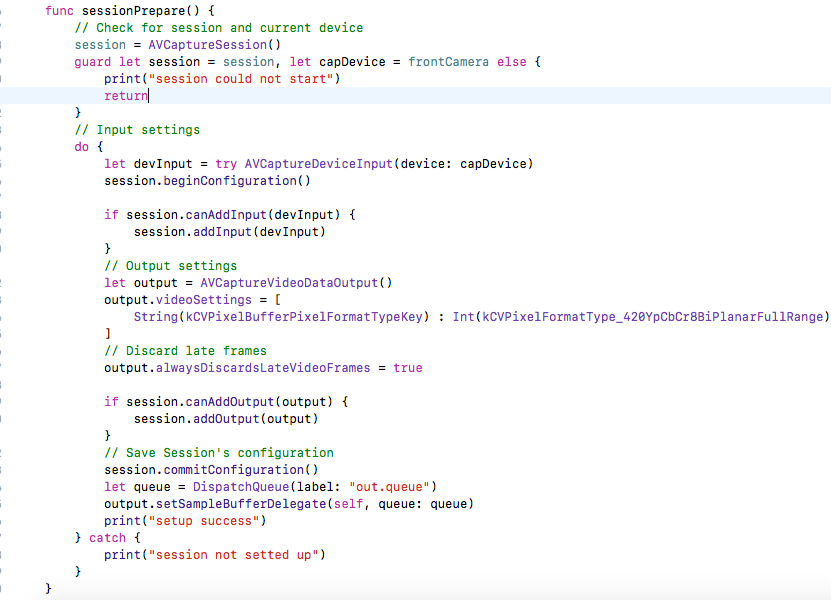
2. Convert Each Of the Live Streaming Frames to Imagery Format
Here’s the piece of code to facilitate the conversion of the live streaming frames to imagery format.

3. Integrate Imagery Data into the Vision Framework
By integrating the imagery data into the Vision Framework, the virtual jewelry try-on application will detect the facial landmarks. Here’s a piece of code that will help.
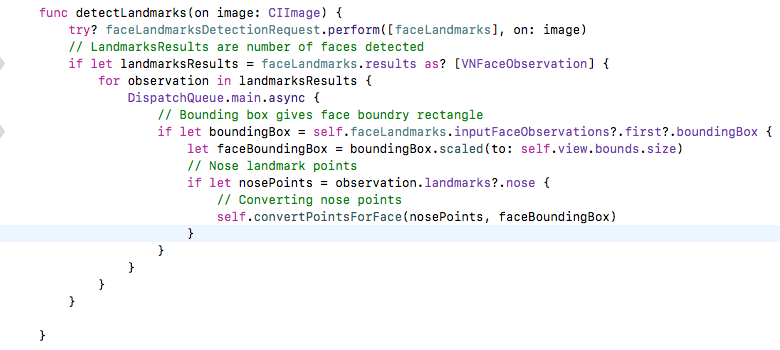
This was the simple process that we followed during the product development process. Now let’s see how we build a virtual jewelry try-on app for a nose ring.
Virtual Jewelry Try-on Application — Delivering the Nose Ring User Story
The Agile Development team worked in time-boxed sprints to deliver the prioritized user stories. And, one of such user stories was enabling virtual nose ring try-on, using face recognition and augmented reality in jewelry.
The first task was to detect the nose parts, where one can wear a nose ring. We used SceneKit and Vision Framework to help identify columella and the alar-sidewalls.
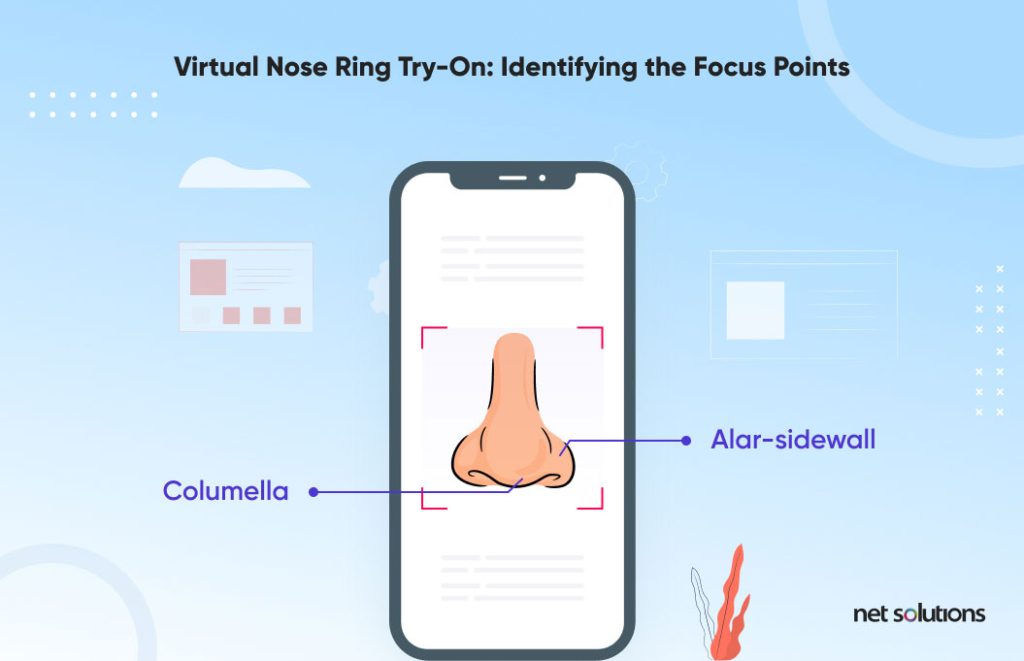
This was the most challenging task for the dev team. How did they work towards it?
They identified the left side of the nose and specified the index of the array equal to six. This helped fix up a point on the live stream layer.
Next, we set up the ideal position for the virtual nose ring try-on, on the SceneKit’s layer. This was done in accordance with the detected point on the live stream layer. However, as there was no in-built function for setting up the index and position on SceneKit, the conversion from one scale to another was a bit taxing.
So, to ensure precision, we created a formula. This helped us with the conversion of a multiplier value and an offset value for placing the nose ring accurately on SceneKit’s layer.
We provided the Z coordinate of the object’s position, a static value of -1 (-ve because the camera’s direction in the scene is towards the -ve Z direction), and the nose ring was oriented in a profile view.
The code shown below will help ensure that the nose ring moves in accordance with the face’s movement.
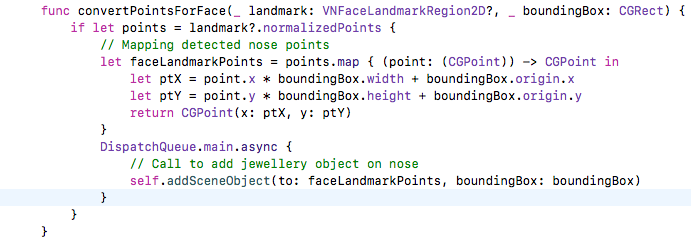
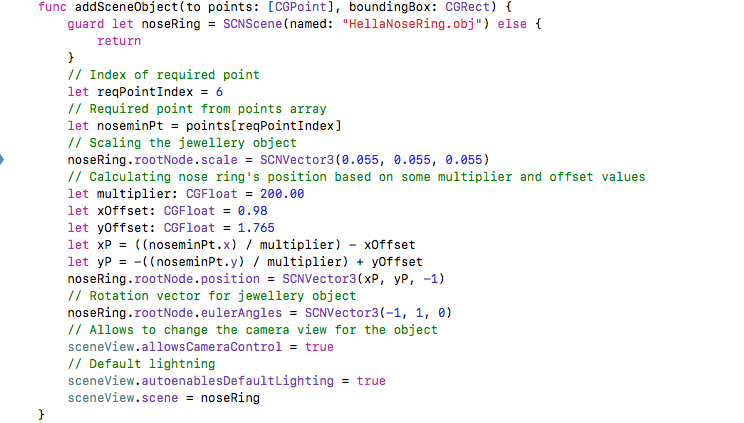
This completes the development part of the virtual nose ring try-on solution.
Conclusion
Augmented reality and facial recognition are strengthening the shift towards eCommerce and online retail. It will improve the cross-channel customer experience, offer a competitive advantage, and reduce the hassle of returns and refunds.
Businesses all across the globe are embracing virtual try on solutions in countless ways and reaping the maximum benefits from augmented reality. Having the right exposure and skills of leveraging AR into your business holds the key to creating jewelry virtual try on solutions for grabbing the attention of your target audience.
The scope of AR and facial recognition is unlimited, and so is the availability of frameworks that help smoothen the process. If you manage to create a product people love, you will be setting an example for the others to follow.
We built a virtual jewelry try-on app for one of our clients who wished to upscale their business by adopting digital transformation — something that every business needs to aim for.
It is kind of imperative to innovate to offer and receive value at the same time!


